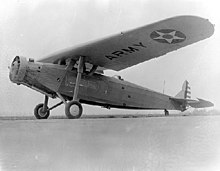| Fokker F-14 | |
|---|---|

| |
| Fokker C-14 | |
| Role | Seven/Nine passenger transport monoplane |
| Manufacturer | Atlantic Aircraft |
| First flight | 1929 |
| Primary user | United States Army Air Corps |
The Fokker F-14 was an American seven/nine passenger transport aircraft designed by Fokker and built by their Atlantic Aircraft factory in New Jersey.
Development[edit]
The F-14 was a typical Fokker designed single-engine transport but unusually it had a parasol-type high wing carried on struts above the fuselage. It had a fixed tailwheel landing gear. The pilot had a cockpit behind the passenger cabin.
Variants[edit]

- F-14
- Civil production version with a 525 hp (391 kW) Wright R-1750-3 radial engine.
- F-14A
- Civilian aircraft with 575 hp (429 kW) Pratt & Whitney R-1690 Hornet radial and wing mounted directly on fuselage.

- Y1C-14
- Designation for 20 Hornet-powered examples bought for the United States Army Air Corps in 1931, later became the C-14.
- Y1C-14A
- Last of the 20 Y1C-14s re-engined with a 575 hp (429 kW) Wright R-1820-7 Cyclone.
- Y1C-14B
- Re-engined with a 525 hp (391 kW) Pratt & Whitney R-1690-5 Hornet.

- Y1C-15
- Conversion of the ninth Y1C-14 as an air ambulance.[1]
- Y1C-15A
- F-14 re-engined with a 575 hp (429 kW) Wright R-1820 Cyclone, later C-15A.
Operators[edit]
Specifications (F-14)[edit]
Data from The Illustrated Encyclopedia of Aircraft (Part Work 1982-1985), 1985, Orbis Publishing, Page 1878
General characteristics
- Crew: 1
- Capacity: seven/nine passengers
- Length: 43 ft 3 in (13.18 m)
- Wingspan: 59 ft 5 in (18.11 m)
- Height: 12 ft 4 in (3.76 m)
- Wing area: 551 sq ft (51.19 m2)
- Empty weight: 4,346 lb (1,971 kg)
- Gross weight: 7,200 lb (3,266 kg)
- Powerplant: 1 × Wright R-1750-3 9-cylinder radial , 525 hp (391 kW)
Performance
- Maximum speed: 137 mph (220 km/h, 119 kn)
- Range: 690 mi (1,100 km, 600 nmi)
- Service ceiling: 14,500 ft (4,420 m)
Related lists
References[edit]
- John Andrade, U.S.Military Aircraft Designations and Serials since 1909, Midland Counties Publications, 1979, ISBN 0-904597-22-9 (Page 62)
- The Illustrated Encyclopedia of Aircraft (Part Work 1982-1985), 1985, Orbis Publishing, Page 1878.
External links[edit]
- "Mercy Flyers Bring" rare photos of USAAC ambulance version page 20 (top) and page 21 (bottom)
- "Ambulance Plan `Chute Designed For Patients" June 1934 Popular Science Monthly - Y1C-15 used for testing of emergency parachute for stretcher patients
Well, that’s interesting to know that Psilotum nudum are known as whisk ferns. Psilotum nudum is the commoner species of the two. While the P. flaccidum is a rare species and is found in the tropical islands. Both the species are usually epiphytic in habit and grow upon tree ferns. These species may also be terrestrial and grow in humus or in the crevices of the rocks.
View the detailed Guide of Psilotum nudum: Detailed Study Of Psilotum Nudum (Whisk Fern), Classification, Anatomy, Reproduction